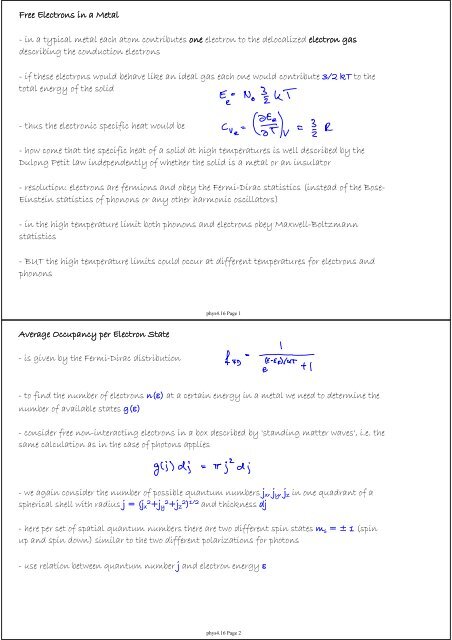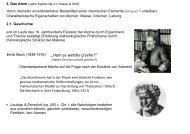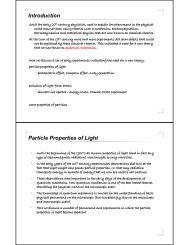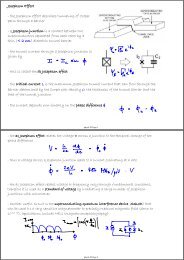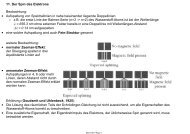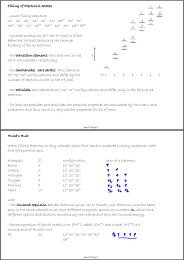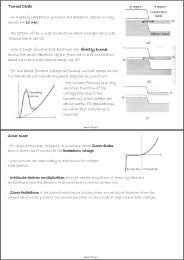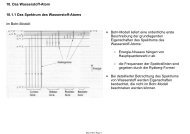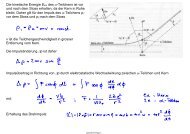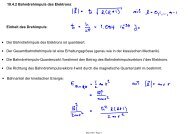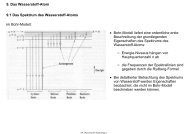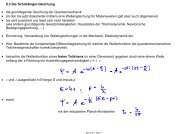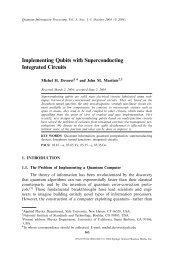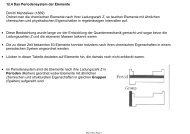Free Electrons in a Metal - in a typical metal each atom contributes ...
Free Electrons in a Metal - in a typical metal each atom contributes ...
Free Electrons in a Metal - in a typical metal each atom contributes ...
Create successful ePaper yourself
Turn your PDF publications into a flip-book with our unique Google optimized e-Paper software.
<strong>Free</strong> <strong>Electrons</strong> <strong>in</strong> a <strong>Metal</strong><br />
- <strong>in</strong> a <strong>typical</strong> <strong>metal</strong> <strong>each</strong> <strong>atom</strong> <strong>contributes</strong> one electron to the delocalized electron gas<br />
describ<strong>in</strong>g the conduction electrons<br />
- if these electrons would behave like an ideal gas <strong>each</strong> one would contribute 3/2 kT to the<br />
total energy of the solid<br />
- thus the electronic specific heat would be<br />
- how come that the specific heat of a solid at high temperatures is well described by the<br />
Dulong Petit law <strong>in</strong>dependently of whether the solid is a <strong>metal</strong> or an <strong>in</strong>sulator<br />
- resolution: electrons are fermions and obey the Fermi-Dirac statistics (<strong>in</strong>stead of the Bose-<br />
E<strong>in</strong>ste<strong>in</strong> statistics of phonons or any other harmonic oscillators)<br />
- <strong>in</strong> the high temperature limit both phonons and electrons obey Maxwell-Boltzmann<br />
statistics<br />
- BUT the high temperature limits could occur at different temperatures for electrons and<br />
phonons<br />
Average Occupancy per Electron State<br />
- is given by the Fermi-Dirac distribution<br />
phys4.16 Page 1<br />
- to f<strong>in</strong>d the number of electrons n(ε) at a certa<strong>in</strong> energy <strong>in</strong> a <strong>metal</strong> we need to determ<strong>in</strong>e the<br />
number of available states g(ε)<br />
- consider free non-<strong>in</strong>teract<strong>in</strong>g electrons <strong>in</strong> a box described by 'stand<strong>in</strong>g matter waves', i.e. the<br />
same calculation as <strong>in</strong> the case of photons applies<br />
- we aga<strong>in</strong> consider the number of possible quantum numbers jx, jy, jz <strong>in</strong> one quadrant of a<br />
spherical shell with radius j = (jx 2 +jy 2 +jz 2 ) 1/2 and thickness dj<br />
- here per set of spatial quantum numbers there are two different sp<strong>in</strong> states ms = ± 1 (sp<strong>in</strong><br />
up and sp<strong>in</strong> down) similar to the two different polarizations for photons<br />
- use relation between quantum number j and electron energy ε<br />
phys4.16 Page 2
Number of <strong>Free</strong> Electron States <strong>in</strong> a <strong>Metal</strong><br />
- relation between electron matter wave quantum number j 2 = (jx, jy, jz) 2 and electron<br />
energy ε <strong>in</strong> a 3D box<br />
- us<strong>in</strong>g deBroglie wave length<br />
- number of electron states at energy ε <strong>in</strong> a volume V = L 3<br />
- this number of states is <strong>in</strong>dependent of the actual shape of the <strong>metal</strong> and only depends on<br />
its volume, i.e. the density of electrons <strong>in</strong> the <strong>metal</strong><br />
Fermi Energy<br />
phys4.16 Page 3<br />
- calculate the total number of electrons at T = 0 to f<strong>in</strong>d the Fermi energy εF<br />
- thus the Fermi energy is given by<br />
- depend<strong>in</strong>g only on the electron density n = N/V<br />
- Fermi energy <strong>in</strong> copper (Cu)<br />
- free electron density<br />
- Fermi energy<br />
- Fermi velocity<br />
phys4.16 Page 4
Electron Energy Distribution<br />
- number of electrons at energy ε at a thermal equilibrium temperature T<br />
- number of electrons (electron density) at<br />
different temperatures<br />
- as the Fermi energy is usually very high<br />
compared to ambient temperature, the energy<br />
distribution of the electrons does vary only<br />
weakly with T<br />
Average Electron Energy<br />
- total electron energy<br />
- average electron energy<br />
phys4.16 Page 5<br />
- these average electron energies are very high, if the electrons were classical particles they<br />
would have to be a temperatures of several 10000 K to have these energies<br />
- specific heat of electrons<br />
- the factor of kT/εF makes this contribution small at room temperature<br />
- at low temperatures cVe ~ T can dom<strong>in</strong>ate over cV ~ T 3<br />
phys4.16 Page 6
The Solid State<br />
- most of the matter <strong>in</strong> the physical world around us (on earth) is <strong>in</strong> the solid state (which is<br />
not true for the universe as a whole)<br />
- solids consist of <strong>atom</strong>s, ions or molecules closely packed together<br />
- the b<strong>in</strong>d<strong>in</strong>g occurs either by covalent, ionic, van der Waals or <strong>metal</strong>lic bonds all of<br />
which are mediated by electromagnetic forces<br />
structure:<br />
- many solids appear <strong>in</strong> crystall<strong>in</strong>e<br />
structure, i.e. the constituents are arranged<br />
<strong>in</strong> a regular, repeated three dimensional<br />
pattern (a lattice) with long range order<br />
- only few solids appear as s<strong>in</strong>gle crystals<br />
(e.g. Silicon (Si)), most consist of very<br />
many small crystallites<br />
Amorphous Solids<br />
- some solids (e.g. glass, plastics) have an<br />
amorphous structure, i.e. they have no long<br />
range but only short range order<br />
- can be viewed as a very viscous (glassy)<br />
liquid which crystallizes very slowly<br />
phys4.16 Page 7<br />
- amorphous and crystall<strong>in</strong>e B2O3<br />
melt<strong>in</strong>g: - <strong>in</strong> amorphous solids the bond strengths varies throughout the material<br />
- as a result melt<strong>in</strong>g occurs slowly and cont<strong>in</strong>uously<br />
- <strong>in</strong> crystall<strong>in</strong>e solids most of the bonds have equal strengths and thus<br />
melt<strong>in</strong>g occurs at a well def<strong>in</strong>ed temperature<br />
phys4.16 Page 8
Crystal Defects<br />
- most crystals have deviations from perfect regularity and<br />
symmetry which are called defects<br />
- one k<strong>in</strong>d of imperfection is the po<strong>in</strong>t defect (see figure)<br />
- they occur when (a) an <strong>atom</strong> is miss<strong>in</strong>g from the regular<br />
crystal structure (vacancy), (b) an additional <strong>atom</strong> of the<br />
same k<strong>in</strong>d occurs (<strong>in</strong>terstitial), (c) an impurity <strong>atom</strong><br />
replaces an <strong>atom</strong> <strong>in</strong> the crystal (substitutional impurity) or<br />
(d) an impurity <strong>atom</strong> occurs at an <strong>in</strong>terstitial position<br />
- defects occur due to thermal excitation, due to irradiation, due to impurities<br />
present dur<strong>in</strong>g the formation of the material<br />
- large truly perfect crystals hardly exist (they can be pretty good though)<br />
- s<strong>in</strong>gle crystal Si (purity 1 ppb = part per billion = 1/10 9 ), see photograph<br />
- diamond<br />
Dislocations<br />
phys4.16 Page 9<br />
- a l<strong>in</strong>e defect corresponds to a miss<strong>in</strong>g l<strong>in</strong>e of <strong>atom</strong>s <strong>in</strong> a crystal,<br />
see (a), it is called a dislocation<br />
- the dislocation may move from <strong>in</strong>side the crystal towards an edge<br />
(see, b-c) releas<strong>in</strong>g the stress from the crystal lattice<br />
- screw dislocation (figure) arises when<br />
the crystal is cont<strong>in</strong>uously displaced along<br />
a cut <strong>in</strong>to the crystal form<strong>in</strong>g a screw like<br />
discont<strong>in</strong>uity <strong>in</strong> which the <strong>atom</strong>ic layers<br />
spiral around a s<strong>in</strong>gle po<strong>in</strong>t<br />
- dislocations are created when solids are deformed<br />
- some solids get harder when they conta<strong>in</strong> many dislocation (work<br />
harden<strong>in</strong>g <strong>in</strong> cold rolled sheet <strong>metal</strong>)<br />
- thermally annealed crystals with less defects may be soft<br />
phys4.16 Page 10
Ionic Crystals<br />
- ionic crystals form between (a pair of) elements with low<br />
ionization energy and high electron aff<strong>in</strong>ity,<br />
- electron aff<strong>in</strong>ity is the energy released by an <strong>atom</strong> when an<br />
electron is added to form a negatively charged ion<br />
- <strong>in</strong> the ionic crystal sodium chloride (NaCl, see figure) one<br />
electron is transferred from Na (ionization energy 5.14 eV) to Cl<br />
(electron aff<strong>in</strong>ity 3.61 eV) form<strong>in</strong>g ions Na + and Cl - which<br />
b<strong>in</strong>d electrostatically when the total energy <strong>in</strong> the crystal is<br />
reduced from that of separate Na and Cl<br />
- m<strong>in</strong>imum ion-ion distance is determ<strong>in</strong>ed by balance between<br />
Coulomb attraction and repulsion due to Pauli exclusion<br />
- the cohesive energy is the energy per <strong>atom</strong> required to break a<br />
the crystal up <strong>in</strong>to ions<br />
- the cohesive energy is provided by the Coulomb attraction with<br />
the neighbor<strong>in</strong>g ions<br />
Attractive Coulomb Potential<br />
phys4.16 Page 11<br />
face centered cubic NaCL<br />
- f<strong>in</strong>d the total Coulomb energy Uc between one ion (e.g. Na + ) and all its neighbors<br />
body centered cubic CsCl<br />
- Uc is determ<strong>in</strong>ed by the number of ions (coord<strong>in</strong>ation number) present at a given<br />
distance r from the ion under consideration<br />
- nearest neighbors<br />
- next nearest neighbors<br />
- summation over all nearest neighbors<br />
- with the Madelung constant α ~ 1.748 for NaCL and all other face centered cubic<br />
(fcc) ionic crystals<br />
- for the body centered cubic (bcc) crystal CsCl the Madelung constant is α ~ 1.763<br />
- all simple crystal structures have Madelung constants α ~ 1.6 - 1.8<br />
phys4.16 Page 12
Repulsive Potential<br />
- repulsive force due to exclusion pr<strong>in</strong>ciple with effective potential<br />
- short range force depend<strong>in</strong>g on a large power n ~ 8 - 10 of the separation r between ions<br />
(empirical model)<br />
- total energy<br />
- equilibrium position<br />
- total energy at equilibrium distance<br />
Properties of Ionic Crystals<br />
- hard, due to ionic bonds<br />
- high melt<strong>in</strong>g po<strong>in</strong>ts due to large b<strong>in</strong>d<strong>in</strong>g energy<br />
phys4.16 Page 13<br />
NaCl: to be reduced by Ei-Eaff<br />
- brittle, due to repulsive forces occurr<strong>in</strong>g with next nearest neighbor ions when dislocations<br />
are formed<br />
- ionic crystals dissolve <strong>in</strong> polar solvents (water) but not <strong>in</strong> covalent solvents<br />
- good electrical <strong>in</strong>sulators, due to strong b<strong>in</strong>d<strong>in</strong>g of electrons to ions<br />
- transparent for visible radiation<br />
- absorb<strong>in</strong>g to <strong>in</strong>frared radiation excit<strong>in</strong>g lattice vibrations <strong>in</strong> the ionic crystal<br />
phys4.16 Page 14


